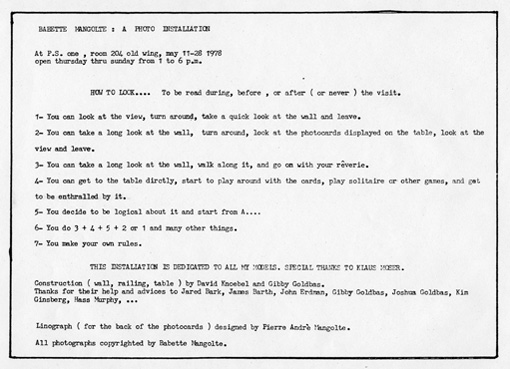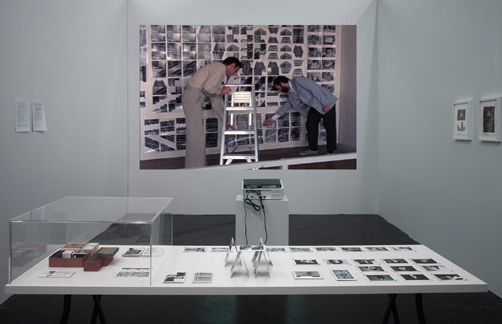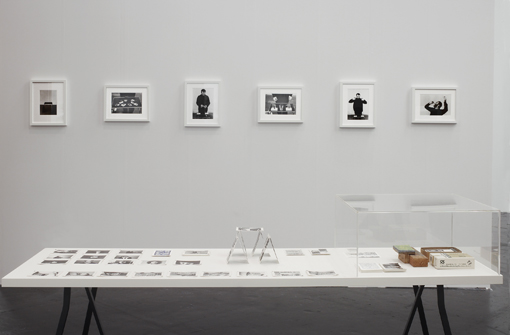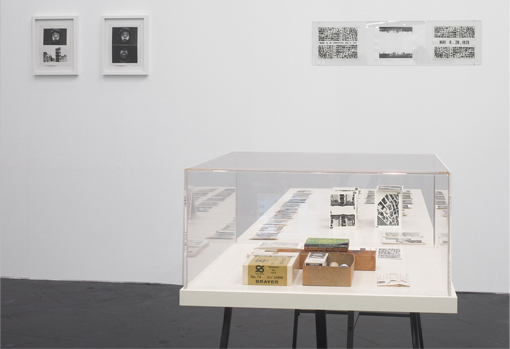|
Program Notes about HOW TO LOOK... at the piece with multiple options (original from 1978)

Two pages script written in 1994-95 for a film that has yet to be made placed at left of screen and describing at length sounds and voice over.
Two vintage photo-montages
from 1977 made as test for a flyer for The Camera: Je, La Camera: I with Stuart Sherman's portrait and a row of building on Canal Street, New York, placed at right of screen. It is the work on the flyer that led to the subsequent 1978 installation re-imagined here.
A table around 2 meters by 50 cm wide with a deck of cards with blue backing that can be manipulated with on the left a glass case protecting the tools used to ink the back of the cards plus a second set of cards with silver backing.



The walls for the installation should be painted very light grey as well as the table and the support for the program notes. The film is projected as a loop on the wall painted with silver paint that increases the brightness of the video projection of the film shot in color about black and white photography. The video projector should be hanged from the ceiling so it is not blocking the view from the table to the screen.
SCRIPT
Music
The voice over start as a recollection of a memory
It was a long time ago...
Long Island City, across the river from New York City
and transformed itself to a reading voice (the voice is very internalized and should not project.)
.. P.S. One, Room 204 .. until May 28, open till 6 p.m.
How to look ... to be read during, before, or after (or never) the visit.
1,2,3,4,5,6,7
This installation is dedicated to all my models
A photo installation How to look...
Reading Scanning the program note very fast on the pan LS program notes
You can look at the view, ....... to be logical about it and start from A ...
The voice over become more interrogative
You really have to look at two things at once.
How can you look at two things at once?
two kinds of pictures, buildings and people ...
Did it say you can touch the photographs?
you, you, you, you, .... (with sound of tearing cards)
CU program notes: Visit Reverie
Cut to LS of the space with nothing disturbed
Music
The voice is constructed as the one of the maker of the photo installation
The show was on for a month. There was no security in the gallery. Often the visitor was left alone in the space for several hours, specially on week days. What could happen?
Several cards were found missing at the end of each days. My biggest surprise was that no more than a couple of photocards were stolen each days, mostly the composite card 10 (my favorite) and two of the portraits cards; there were of famous personalities in the Soho Art World of the time and I was prepared with replacement cards.
....and able to transgress and invents his rules. Opened four days a week, every days some of the cards on the table were missing. Strangely enough the wall was never touched. The show was read as a play on distance. The cards, which disappeared the most, were the one of Kate and Richard, two celebrities of the portraits series. One of the composite pictures was also a great favorite. Nobody was interested in the baby pictures, as expected.
Surprisingly so few visitors gave themselves the permission to be outrageous with the installation. Give permission: that was what the show was all about. The visitor was given the possibility to invent, subvert, and redefine its own rules. The concept for the show was simple: the distance at which you see construct what you see.
I am not sure that visitors were able to identify several viewing experiences for themselves. The program notes alluded to a multiplicity of readings but most people privileged one. The majority was fascinated with the large wall. The size was an impressive 24 feet by 16 feet. The distance of the banister was at 12 feet. The banister was outlining the diverseness of the visitor’s experience of the show. Another way to describe it: see the details up close with the cards, or see the whole at a distance: one or the other. Few people experienced both.
About the wall you can’t see it in one look. You’re too far to see details, to close to see it in its entirety without moving your head.
I dreamt of a revolt.
I never knew who had opened the window, or who gave the sign to start ripping everything apart.
The photographs suddenly were seen without frame.
Fragmentation is self-contained and impossible.
|